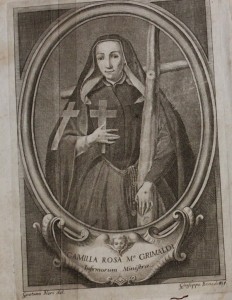 Few people have had in their hands a picture in which a woman, naturally with a veil, is wearing a habit that evokes in an expressive way the figure of St. Camillus de Lellis (1550-1614), with a red cross on the front and her mantle, while on the sash there is a large crown of the rosary. She is holding in her arm a cross of wood, while on a small table there are references to penitence and death, as was common with the symbolic references of the time. Here we have Rosa Camilla Grimaldi.
Few people have had in their hands a picture in which a woman, naturally with a veil, is wearing a habit that evokes in an expressive way the figure of St. Camillus de Lellis (1550-1614), with a red cross on the front and her mantle, while on the sash there is a large crown of the rosary. She is holding in her arm a cross of wood, while on a small table there are references to penitence and death, as was common with the symbolic references of the time. Here we have Rosa Camilla Grimaldi.
Her Birth and her Search for her Vocation
Rosa Camilla Grimaldi was born in Bologna on 15 March 1798 to Giuseppe and Maria Monterumesi in the Parish of S. Salvatore; she was baptised on the following 17 March in the Metropolitan Church of St. Peter.
She lived her early years in a good environment, dedicating herself above all to prayer and to the search for her own vocation, always under the guidance of spiritual Fathers (Fr. Aurelio Castagna, a Barnabite, and later Fr. Canini and Fr. Mapsone, Camillians who were at the Church of St. Gregory in the city). Her first choice was to try religious life amongst the women Tertiaries of St. Chiara, given that she had formed a good impression of them when they had come to her home collecting alms. But she then realised that this was not her pathway.
Her Prayer and Life at the Side of the Suffering
A new pathway then began, again in her own home: after saying her prayers she dedicated herself to works of charity, beginning to go to the hospital, and it was there that she was everything with everyone: infirm with the infirm, weak with the weak, afflicted with the afflicted, bearing with so much love and patience the difficulties of her arduous ministry.
It was written of her: ‘Even though Camilla generally had a melancholic character and was often troubled by afflictions of the spirit, however her nature appears to have changed completely when she was amongst her own poor people’.
Even before wearing a religious habit with a red cross, Rosa continued to be involved in service to sick poor women at the hospital and in private homes with constant forms of help. She could often be seen in the hospital cutting women’s nails, washing their hands, cleaning the most lurid instruments, and this to the point of receiving rebukes from some ward head because such tasks were only for the lowest servants.
Following Christ and the Example of Camillus
It was thus that at a certain point of her life, after learning about the life of Camillus de Lellis and the Ministers of the Sick, Rosa decided to become a Camillian woman Tertiary, wearing the same habit as those religious. Circumstances postponed this wish but in the end a letter reached the Father General by which Rosa Grimaldi was admitted to the formal vestition of the habit, on the condition, however, that this young woman obtained the written permission of the Archbishop and had a sufficient amount of money to maintain herself in a decent way. But two other difficulties arose specifically at that moment: the servant of God fell gravely ill to the point that people feared for her life and a decree issued at that time by the Archbishop Cardinal Lambertini prohibited all religious from admitting women Tertiaries, who in addition to not having a suitable amount of money had also not reached the age of forty, to canonical vestition
Rosa, who at that time was thirty, did not despair of the help of God: a certain Bartolomeo Vizani provided the sum of money and the problem of her age was overcome through the presentation of a weighty documentation made up of pontifical decrees and statements, as well as testimonies about the life of this young women. By a written letter of 8 December 1740, the Archbishop  recognised that the Ministers of the Infirm had the privilege of having women Tertiaries and as a consequence Grimaldi received a dispensation as regards her age. On 13 December her solemn vestition took place in the Church of St. Gregory in the presence of the Ministers of the Sick who lived in that house, with numerous faithful as well. From that day on, Rosa bore the name of Camilla Rosa, thereby to make herself, in name as well, a true disciple and perfect imitator of the Founder, Camillus de Lellis.
recognised that the Ministers of the Infirm had the privilege of having women Tertiaries and as a consequence Grimaldi received a dispensation as regards her age. On 13 December her solemn vestition took place in the Church of St. Gregory in the presence of the Ministers of the Sick who lived in that house, with numerous faithful as well. From that day on, Rosa bore the name of Camilla Rosa, thereby to make herself, in name as well, a true disciple and perfect imitator of the Founder, Camillus de Lellis.
Predictions of Camilla Rosa Regarding her Death and Burial
Camilla Rosa, despite the good health she enjoyed at the time, began to speak about her death in precise terms, and with such details about the circumstance that she seemed to make people believe that she was talking about past history. On 4 December 1738 she wrote as follows: ‘I realise that I do not have a long time to live and that I will die at the age of thirty-three, after forty-three hours of dying, to resemble the crucified Christ’. She also foretold that she would not reach the end of her novitiate, that she would have made her profession in bed, and that she would die on the first Saturday of August, the holy day of the Virgin.
The Last Illness of the Servant of God and her Religious Profession
On 24 July she went to bed with such a strong fever that everyone predicted her death; and whereas the event was deplored everywhere she herself was joyous about it, as though she had encountered it on the eve of her greatest and most wished-for solemnity. After making a general confession about all her life, and strengthened by the bread of the Angels, which she received as viaticum on the last day of the same month, she said to her confessor: ‘I would like you to communicate to Father Prefect Scali my wish to be aggregated to the body of our religion, confessing before my death’.
On the next day, 1 August, Fr. Scali, the prefect of the house of St. Gregory, happy to be able to provide the Servant of God with the glad tidings that her requests had been met, drew near to the bed of the sick woman to admit her to religious profession. This Camilla made in the presence of her confessor and Fr. P. Mancini.
The Painful Dying, the Death and the Burial of the Servant of God
Fervent prayers were raised up everywhere and her confessor, sadly deceiving himself, hoped for a miracle worked by the mercy of God. At 19.00, on 3 August, he saw the Servant of God transformed, with her eyes darkened over, her face pale, and the whole of her person falling into the deepest faint. Without any hesitation, her confessor asked the Father Prefect to minister extreme unction to the dying woman.
The Servant of God shook herself for a moment, received this last comfort of the faith with strong feelings, and in terms dictated by the most profound humility asked to be once again fortified by the bread of the Angels.
After her wishes had been met, it remained to Camilla only to bear with heroic patience the tribulation and the sufferings of her dying, which after beginning at 19.00 would, according to her predictions, purify her for as long as forty-three hours in memory of the thirty-three years of life of Jesus Christ, the seven sorrows of the Most Holy Virgin, and the three hours of dying suffered by the divine Redeemer.
In the meanwhile, on 5 August, the sacred day of the solemnity of the Virgin Mary, which that year fell precisely on that day, arrived, and at 11.00 the Servant of God gave up a loud cry and uttered the following words: ‘Jesus, Jesus, great God, help me’. The heavenly Spouse granted this request: at 14.00, Saturday, 5 August 1741, she breathed her last in the embrace of the Lord, surrounded, as one supposes, by a Choir of Angels, who transported her to the breast of her heavenly Spouse in Heaven.
Shown according to the customs of the time, the body of the Servant of God was buried near to the tomb of young people, as Camilla had said would happen when she was still alive, that is to say to be awaited by Puttini (translator’s note: childlike angels similar to cherubim) and to be near her religious.
Later, that is to say on 20 October, after the necessary permits had been obtained, the solemn recognition of her corpse was carried out and was once again buried with those formalities that were prescribed by the law. The corpse was placed in two coffins and put in a place where the following words were inscribed: camilla rosa grimaldi, professed woman minister of the sick who died at the age of thirty-three on 5 august 1741.



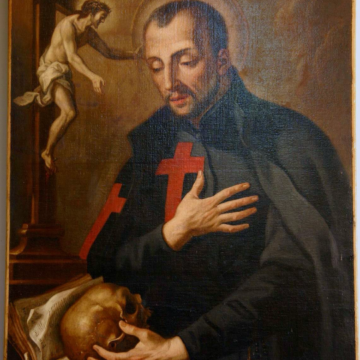

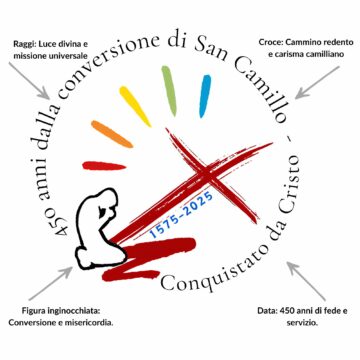




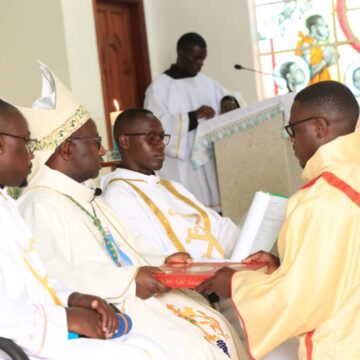
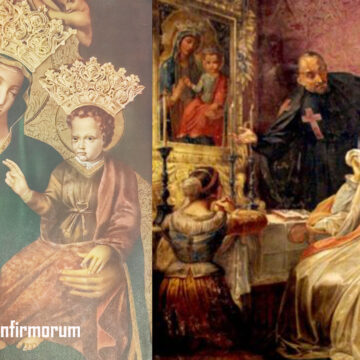
Camillians on Facebook
Camillians on Twitter
Camillians on Instagram